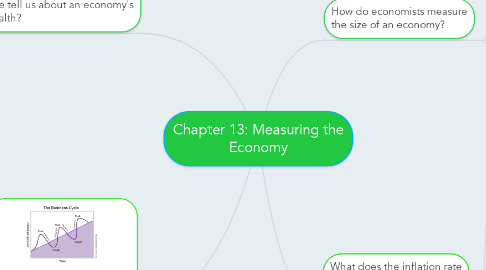Chapter 13: Measuring the Economy
by Brooke St. Germain

1. What does the unemployment rate tell us about an economy's health?
1.1. When the unemployment rate of a nation is high, it means the economy is failing. When the unemployment rate of a nation is low, that means the economy is doing well.
1.2. The Bureau of Labor Statistics classified people as employed, unemployed, or not in the labor force. Employed people have jobs in the labor force, unemployed people do not have jobs in the labor force but are actively seeking a job, and people who are not in the labor force do not have a job nor are they seeking work.
1.3. Even though not all people seeking work are employed, that doesn't mean an economy is unhealthy. There will never be 100% employment, but that doesn't mean the labor force is being used inefficiently. As long as a nation stays around the natural rate of unemployment, between 4-6%, it is considered healthy.
1.4. Bureau of Labor Statistics - A government agency that collects and analyzes economic data
1.5. Unemployment Rate - The percentage of the labor force seeking work
1.6. This article points out all of the negative impacts that a high unemployment can have on the economy's health, including society in general.
2. How does the business cycle relate to economic health?
2.1. The business cycle isn't a systematic way to predict how the economy will act. Cycles can go through longer peaks as well as longer troughs, so the health can't be determined by just the pattern of the cycle itself.
2.2. A business cycle follows 4 steps: expansion, peak, contraction, and trough. Expansion indicates economic growth, peak obviously indicates economic peak, contraction is a fall due to lowering GDP and a raise in unemployment, and a trough is the lowest point of contraction. This isn't always bad, though, because that means the economy will start to grow after that point.
2.3. The economy can go into a recession, therefore decreasing economic health, by a negative shock to the economy, a rise in interest, and shortages of materials. We can consider this a prolonged period of contraction in the business cycle.
2.4. Business Cycle - Recurring periods of growth and decline in economic activity that all economies experience
2.5. Recession - A decline in economic activity lasting at least six months. During a recession, real GDP falls, as do real wages, employment, profits, and production
3. How do economists measure the size of an economy?
3.1. We measure the size of a nation's economy using it's GDP, or gross domestic product.
3.2. GDP is calculated by adding together household consumption, business investments, government purchases, and the net of exports minus imports. (C + I + G + NX = GDP)
3.3. GDP has many limitations, including not accounting for illegal exchanges, volunteer or unpaid work, it ignores negative externalities, and places no value on leisure time.
3.4. GDP (Gross Domestic Product) - Market value of all final goods and services produced within a country during a given period of time
3.5. Final Good - Any new good that is ready for use by a consumer
4. What does the inflation rate reveal about an economy's health?
4.1. Inflation of any kind can cause economic cost, such as loss of purchasing power, higher interest rates, and loss of economic efficiency.
4.2. There are three measures of inflation. Hyperinflation is a quick and extreme rise in inflation and can't be predicted, which is not good. Creeping inflation is a slow and low increase in inflation, which is what happens today and what we call normal. Finally, there's deflation, which is actually a drop in inflation, which is good for consumers but bad for businesses.
4.3. The consumer price index is what we use to measure what the actual inflation rate is and keeps the same market base.
4.4. Inflation Rate - Percentage increase in the average price level of goods and services from one month or year to the next
4.5. CPI (Consumer Price Index) - A price index for a “market basket” of consumer goods and services, changes in the average prices of these items approximate the change in the overall cost of living


